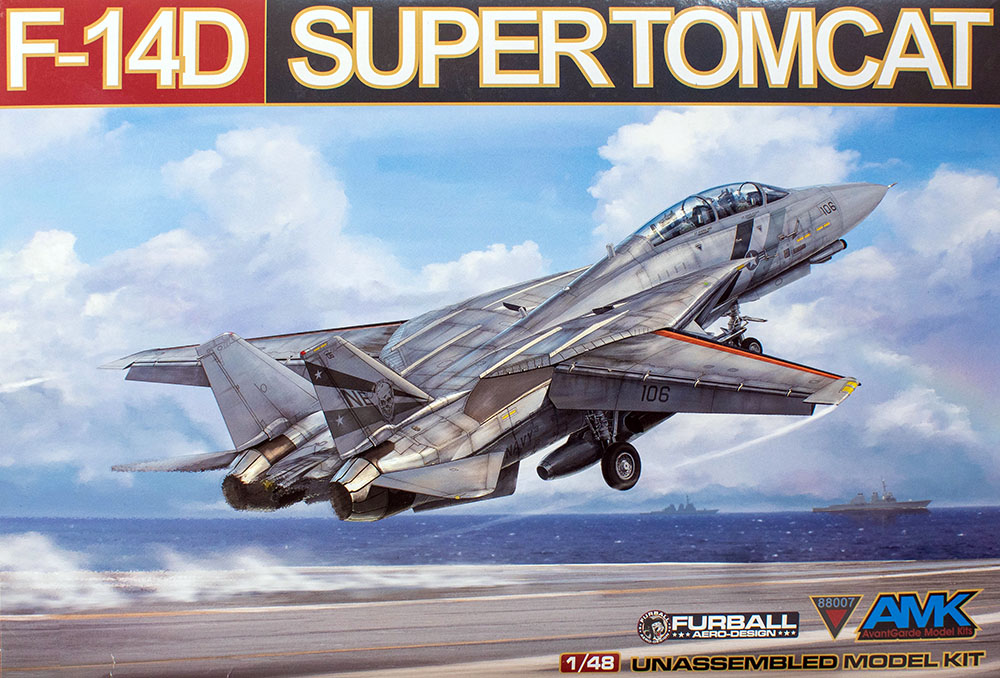
AMK 1/48 F-14D Super Tomcat Kit First Look
By Michael Benolkin
| Date of Review | December 2019 | Manufacturer | AvantGarde Model Kits (AMK) |
|---|---|---|---|
| Subject | F-14D Super Tomcat | Scale | 1/48 |
| Kit Number | 88007 | Primary Media | Styrene, Photo-Etch |
| Pros | Stunning details | Cons | See text |
| Skill Level | Experienced | MSRP (USD) | $68.99 |
First Look
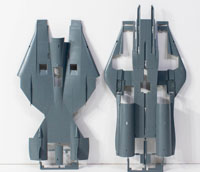 |
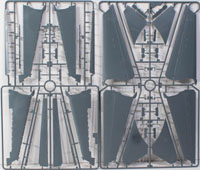 |
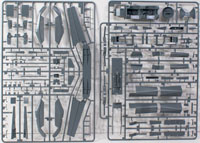 |
 |
 |
 |
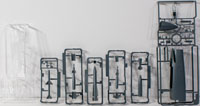 |
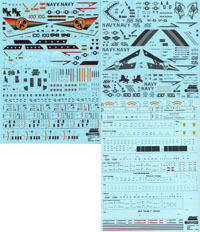 |
Much has been written about the F-14 Tomcat over the years, but let's take a quick look at its timeline anyway. After the cancellation of the Navy's fleet defense fighter under the TFX program (F-111B), much of the special development was recycled into a new airframe designed by Grumman as the F-14 Tomcat. The key systems included the AWG-9 radar with its track-while-scan capability and the ability to engage six targets at the same time using the new AIM-54 Phoenix missile. As the aircraft entered service, two shortcomings were quickly revealed: First, the TF-30 engines that also came over from the F-111B lacked sufficient thrust for aerial combat (an F-14A could out-turn an F-15 for 180 degrees of combat turn, but the F-15 had the thrust to sustain that turn, the F-14A simply ran out of energy for a sustained fight) as well as limitations on weapons loads going off and coming back aboard the ship also due to its limited power. Second, while the AWG-9 had superior multi-target engagement capabilities over water, the radar didn't have look-down capabilities over land. This led to crews driving into hostile airspace at lower altitudes to keep hostiles above them for optimum radar function.
With the development of the F101 derivative fighter engine (DFE) that became the F110, the F-14B was fitted with the more powerful engine that allowed the Tomcat to finally maneuver with the F-15. In addition to new-production F-14B airframes, many F-14As were re-engined to become F-14B. After the USS Vincennes incident that shot down an Iranian airliner, rules of engagement (ROE) were revised to mandate a visual ID of the target before engaging. Even with the Television Camera System (TCS) under the nose of the F-14, by the time visual ID was made, the Tomcat would be too close to launch the AIM-54 which limited the F-14 to the AIM-7 and AIM-9 missiles in many cases. In an effort to expand the F-14's utility aboard the aircraft carrier, the Bombcat was a modification that allowed a targeting pod to be carried under one wing glove while a variety of laser-guided and GPS-guided munitions were carried under the pallets that were used for the AIM-54s.
The F-14D was a major upgrade over the F-14B, while it retained the F110 engines, it received the APG-71, which was a digital system replacing the analog AWG-9 and featuring the capabilities of the APG-70 from the F-15E Strike Eagle, one of which allowed look-down/shoot-down capability. The F-14D also featured other upgrades including the NACES ejection seats, an improved infrared search-track system (IRST) alongside the TCS under the nose, Link-16, and an improved electronic warfare suite. As with the F-14B, a number of new airframes were produced in the F-14D configuration while more were upgraded from older Tomcat airframes. Despite the Tomcat's capabilities, the aircraft became too expensive to maintain/operate and it was retired in favor of the F/A-18 Super Hornet.
Over four years ago, AvantGarde Model Kits (AMK) announced a new-tool 1/48 F-14D Tomcat kit, and the modeling community was excited. AMK strived to get this kit right, and with lots of feedback coming in from Tomcat experts from around the world, the company made revisions to their tooling accordingly. This led to the previously announced release date to come and go with no new plastic on the shelf. After further delays however, AMK has released their F-14D kit and much to my surprise, despite all of the extra work that went on behind the scenes, AMK released kit without much of a price increase over their original announcement which is impressive in itself. Looking at prices online, I've seen this kit range from $55 - $85 (it pays to shop around) which compares pricewise to Tamiya's 1/48 F-14D kit. This is here where that parity ends, but more on that later.
This kit is molded in dark gray styrene and presented on 53 parts trees plus one tree of clear parts and one small fret of photo-etched parts (duplicate trees not shown). The slide molding in this kit are very nicely done. For example, the forward fuselage is one hollow part and you slide the completed cockpit into place during assembly. Many of the parts trees are individual weapons presented in similar fashion to the weapons in a Great Wall Hobby kit. Among the features and options of the kit:
- Nicely detailed NASES ejection seats with photo-etched crew restraints
- Beautifully detailed cockpits with sharp detail relief
- Positionable boarding ladder
- Positionable canopy
- F110 engines have detailed compressor faces and afterburner chambers, no details on the engine sides where they won't be seen
- Choice of open or closed F110 engine nozzles
- Detailed intake trunks from inlet to compressor face
- Detailed landing gear and wheel wells
- Choice of nose gear strut - normal or kneeling
- Positionable leading edge flaps with swept-forward option
- Positionable trailing edge flaps with swept-forward option
- Wings can be posed swept full-forward, full aft (not oversweep), or parked (oversweep)
- Positionable stabilators
- Positionable speed brakes
- Positionable air refueling probe
- Positionable tail hook
The kit provides the following external stores options:
- Choice of under-fuselage pallets - Phoenix or Bombcat
- Choice of wing glove pylons - Phoenix, Sparrow, Sidewinder, or one targeting pod (in addition to the shoulder-mounted Sidewinder rails)
- 2 x External Tanks
- 1 x TARPS
- 4 x AIM-54C
- 4 x AIM-7M
- 4 x AIM-9M
- 4 x GBU-12
- 4 x GBU-16
- 4 x GBU-31
- 4 x GBU-38
The decals for this release are on three sheets including an extensive set of airframe and weapons stencils. These decals were designed by Furball-Aero Designs. The subjects provided in this release include:
- F-14D, 164348, VF-213, NH/100, USS Carl Vinson, 2002, CAG aircraft
- F-14D, 164342, VF-2, NE/106, USS Constellation, 2003
- F-14D, 164600, VF-31, NK/100, USS Abraham Lincoln, 1997, CAG aircraft
- F-14D, 164604, VX-9, XF/1, NAS China Lake, 2000
- F-14D, 163900, VF-101, AD/155, NAS Miramar, 2005
While I don't know who printed the decals (not Cartograf or Microscale), these look really sharp with very thin carrier film extending beyond the printed colors.
Earlier I compared the price of this kit being comparable to Tamiya's recent F-14D. While they are both nice kits, the Tamiya kit falls into the category of a simple assembly build. Before the Tamiya kit, the only 'simple build' option was Academy's kit (despite its shape challenges), with simple build being defined as few options/simple engineering. The other category is the super-detailed Tomcat, with options for drooped flaps/slats, kneeling nosewheel, and more. Until now, the primary super-detailed kit option was Hasegawa's Tomcat releases, though Trumpeter/HobbyBoss released scaled-down versions of their 1/32 Tomcats, the 1/48 kit is a bit over-engineered (details where you won't see them after assembly) and a dose of the 'mad riveter' on the kits' surfaces. With the AMK kit, you've got all of Hasegawa's options, most of Trumpeter/HobbyBoss' options, and some really impressive molding. I was impressed with the slide-molded one-piece hollow nose section and the thinly molded see-through vents around the airframe.
This isn't going to be a simple model to build as the tolerances from CAD-designed tooling coupled with complex shapes coming together will require attention to any mold flash/mold stub remnants being cleaned up. Test-fit, build a little, test-fit more, etc. This isn't much different than fitting together the Hasegawa kit, though the sharp details of the AMK tooling will be more pleasant to view. If you're looking for an easy build, go with the Tamiya kit. In fact, if you're like me, I only want one super-detailed Tomcat on my shelf, so that will be either this AMK or Hasegawa kit from my stash, while the variety of other Tomcats to showcase the variety of colorful airframe colors from different squadrons will go to the Tamiya kits.
Here are most of the colors called for by AMK along with equivalent colors from other paint companies:
H301
B030
C030
H307
B035
C035
XA1135
H308
B037
C037
A065
XA1136
H318
H326
H337
B046
C046
XA1126
H002
N002
B125
C125
A012
36107
X01
H011
N011
XF02
H012
N012
B041
C041
XF01
H018
N018
36191







